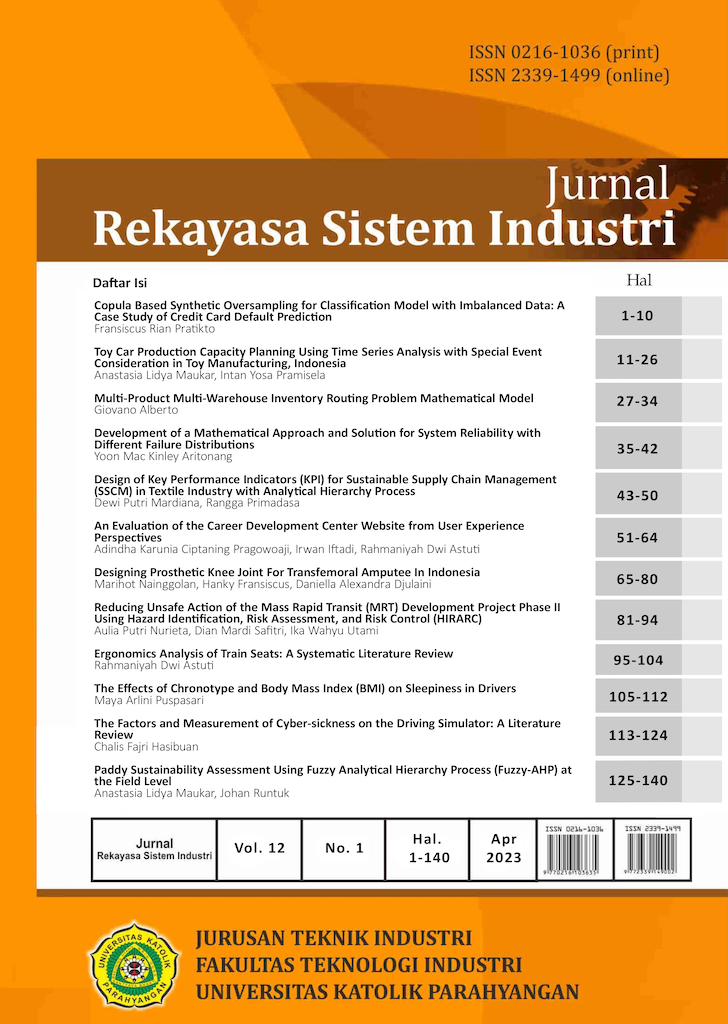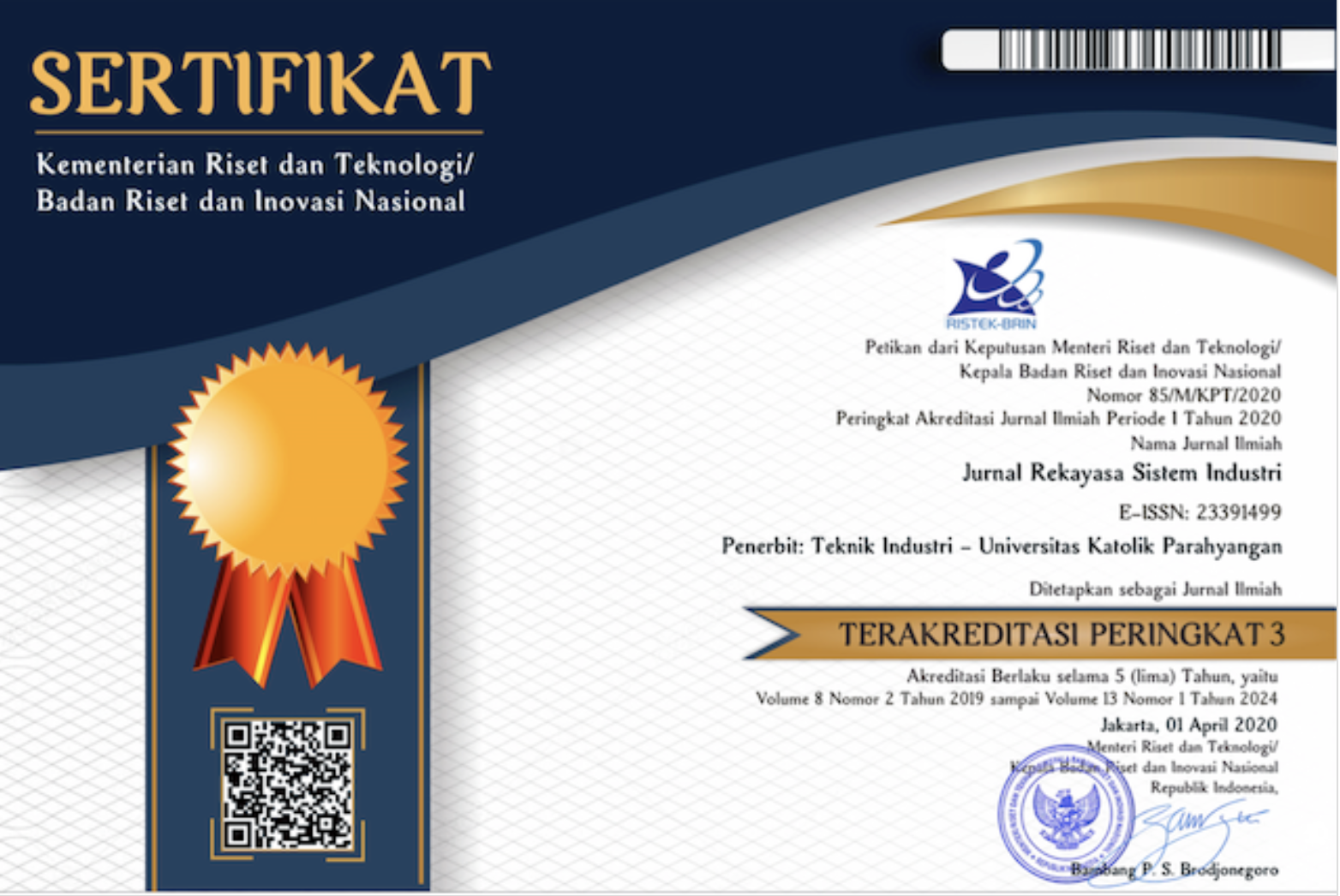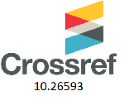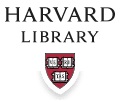Penilaian Keberlanjutan Padi Pada Tingkat Lahan Pertanian/Field Level Menggunakan Fuzzy Analytical Hierarchy Process (Fuzzy-Ahp
DOI:
https://doi.org/10.26593/jrsi.v12i1.5951.125-140Kata Kunci:
Kata kunci: Keberlanjutan, Pembangunan berkelanjutan, Pertanian berkelanjutan, Keberlanjutan beras, Penilaian keberlanjutan, Penilaian rubrik, Proses hierarki analitik fuzzy, Ekonomi, Sosial, LingkunganAbstrak
Perkembangan berkelanjutan di bidang pertanian diperlukan untuk menjaga kelangsungan dari aspek ekonomi, sosial dan lingkungan. International Rice Research Institute memiliki tujuan terkait, seperti meningkatkan kesehatan dengan meningkatkan nutrisi dan keamanan beras dan membuat sistem beras yang ramah lingkungan. Sejalan dengan itu, ada tujuan pembangunan berkelanjutan oleh PBB terkait yang menghilangkan dan mengakhiri kelaparan di mana-mana, menerapkan ketahanan pangan dan meningkatkan gizi serta mempromosikan pertanian berkelanjutan. Oleh karena itu, pertanian keberlanjutan perlu dipertimbangkan sebagai tindakan untuk mewujudkan tujuan tersebut. Penelitian ini bertujuan untuk mengidentifikasi kriteria, sub kriteria dan indikator penilaian serta untuk melakukan penilaian terhadap pertanian padi berkelanjutan di dua desa di Karawang, yaitu Parungsari dan Pasirjengkol. Penilaian terdiri dari kriteria, sub kriteria dan indikator. Bobot kriteria dan sub kriteria juga diperoleh dari pakar dan dihitung dengan menggunakan metode Fuzzy-Analytical Hierarchy Process (Fuzzy-AHP). Kemudian, rubrik ditentukan dan penilaian dilakukan dan dibandingkan dengan standar. Hasilnya, kedua wilayah tersebut memiliki indikator skor rendah. Hasil skor penilaian kriteria ekonomi, sosial dan lingkungan Parungsari adalah 1,679; 2.615; dan 3.495. Hasil skor penilaian kriteria ekonomi, sosial dan lingkungan Pasirjengkol adalah 1,745; 2.588; dan 3.189. Rekomendasi perbaikan juga diberikan untuk setiap indikator skor rendah.
Referensi
Arora, P., Peterson, N. D., Bert, F., & Podesta, G. (2016). Managing the triple bottom line for sustainability: A case study of argentine agribusinesses. Sustainability: Science, Practice, and Policy, 12(1), 60–75. https://doi.org/10.1080/15487733.2016.11908154
Asuquo, D. E., & Onuodu, F. E. (2016). A Fuzzy AHP Model for Selection of University Academic Staff. International Journal of Computer Applications, 141(1), 19–26. https://doi.org/10.5120/ijca2016908969
Badan Teknologi Nasional. (2013). Undang-Undang Republik Indonesia No. 19 Tahun 2013 Tentang Perlindungan dan Pemberdayaan Petani. Jakarta: Sekretariat Negara.
Ceballos, F., Kannan, S., Kramer, B., Chakraborty, I., Maity, P., Barrett, C. B., December, A., FSIN, GAIN, Huang, C., Wang, Y., Li, X., Ren, L., Zhao, J., Hu, Y., Zhang, L., Fan, G., Xu, J., Gu, X., … Haneishi, Y. (2020). The Sustainable Development Goals Report 2019. In United Nations (Vol. 136, Issue 2, pp. 1–64). https://doi.org/10.1016/j.worlddev.2020.105126%0Ahttps://doi.org/10.1016/j.crsust.2020.100014%0Ahttps://undocs.org/E/2019/68%0Ahttps://www.academia.edu/download/65144991/TJF_Brief_2020_04_COVID_19_Implication_to_Food_Security.pdf%0Ahttps://www.financialex
Gerasimova, K. (2017). Our common future. Our Common Future, 1–89. https://doi.org/10.4324/9781912281220
Gnanavelbabu, A., & Arunagiri, P. (2018). Ranking of MUDA using AHP and Fuzzy AHP algorithm. Materials Today: Proceedings, 5(5), 13406–13412. https://doi.org/10.1016/j.matpr.2018.02.334
Hafsah, M. J., & Sudaryanto, T. (2004). Sejarah Intensifikasi Padi dan Prospek Pengembangannya. In Ekonomi Padi dan Beras Indonesia (pp. 19–29). https://www.litbang.pertanian.go.id/buku/ekonomi-padi-beras/BAB-II-1.pdf
Latruffe, L., Diazabakana, A., Bockstaller, C., Desjeux, Y., Finn, J., Kelly, E., Ryan, M., & Uthes, S. (2016). Measurement of sustainability in agriculture: A review of indicators. Studies in Agricultural Economics, 118(3), 123–130. https://doi.org/10.7896/j.1624
Mohamed Noor, A. Z., Fauadi, M. H. F. M., Jafar, F. A., Nordin, M. H., Yahaya, S. H., Ramlan, S., & Shri Abdul Aziz, M. A. (2017). FUZZY analytic hierarchy process (FAHP) integration for decision making purposes: A review. Journal of Advanced Manufacturing Technology, 11(2), 139–154.
Mohamed, Z., Terano, R., Sharifuddin, J., & Rezai, G. (2016). Determinants of Paddy Farmer’s Unsustainability Farm Practices. Agriculture and Agricultural Science Procedia, 9, 191–196. https://doi.org/10.1016/j.aaspro.2016.02.120
Musumba, M., Grabowski, P., Palm, C., Snapp, S., Nziguheba, Prasad, V., Thorne, P., & Vanlauwe, B. (2017). Guide for the Sustainable Intensification Assessment Framework. In Feed the Future.
Nurliza, N., Dolorosa, E., & Hamid A. Yusra, A. (2017). Farming Performance of Rice Farmer for Sustainable Agriculture and Food Security in West Kalimantan. AGRARIS: Journal of Agribusiness and Rural Development Research, 3(2). https://doi.org/10.18196/agr.3248
Pemerintah Indonesia, Peraturan Pemerintah Republik Indonesia No. 7 Tahun 1973 Tentang Pengawasan Atas Peredaran, Penyimpanan dan Penggunaan Pestisida. Jakarta: Sekretariat Negara, 1973. http://perundangan.pertanian.go.id/admin/file/PP%20No.7%20Tahun%201973%20Pengawasan%20Pestisida.pdf
Pemerintah Indonesia. (2017). Acuan Penetapan Rekomendasi Pupuk N, P, Dan K Pada Lahan Sawah Spesifik Lokasi (Per Kecamatan). Jakarta: Sekretariat Negara, http://psp.pertanian.go.id/assets/file/66d1189256a51f097c2863e1b0411107.pdf
Pemerintah Indonesia (2007). Peraturan Menteri Pertanian No.23 Tahun 2007 Tentang Pedoman Umum Peningkatan Produktivitas dan Produksi Padi, Jabung dan Kedelai Melalui Bantuan Benih. Jakarta: Sekretariat Negara, http://perundangan.pertanian.go.id/admin/p_mentan/Permentan-23-07.pdf
Pemerintah Indonesia. (2013). Undang-Undang Republik Indonesia No. 19 Tahun 2013 Tentang Perlindungan dan Pemberdayaan Petani. Jakarta: Sekretariat Negara, 2013. http://perundangan.pertanian.go.id/admin/uu/UU%20No.19%20Tahun%202013%20Perlindungan%20&%20Pemberdayaan%20Petani.pdf
Pemerintah Indonesia. (2017). Peraturan Menteri Perdagangan No.57 Tahun 2017 Tentang Harga Eceran Tertinggi (HET) Beras. Jakarta: Sekretariat Negara, 2017. http://supplychainindonesia.com/new/download/1160/
Sahu, M., & Sahu, J. K. (2016). Sustainability of Indian Agriculture: A Triple Bottom Line Approach. International Research Journal of Engineering and Technology, 03(11), 622–628. www.irjet.net
Setiani, I., & Muharromah, I. A. (2019). Pelaksanaan Diseminasi Varietas Unggul Padi Sebagai Upaya Komunikasi Pemasaran Produk Nuklir. Majalah Semi Ilmiah Popular Komunikasi Massa, 1(1), 71–80.
Singh, M. V. (2014). An Impact and Challenges of Sustainable Development in Global Era Enabling everyone to be capable and free to do things and be the person they want to be is the goal of human development . As mentioned in the introduction , human development is in princip. 2(2), 327–337.
Talukder, B., Saifuzzaman, M., & Vanloon, G. W. (2016). Sustainability of agricultural systems in the coastal zone of Bangladesh. In Renewable Agriculture and Food Systems. https://doi.org/10.1017/S1742170515000095
Terano, R., Mohamed, Z., Shamsudin, M. N., & Latif, I. A. (2015). Farmers sustainability index: The case of paddy farmers in state of Kelantan, Malaysia. Journal of the International Society for Southeast Asian Agricultural Sciences, 21(1), 55–67.
Wahab, M., Abdulrachman, S., & Guswara, A. (2017). Daftar Periksa Budidaya Padi Sawah Lahan Irigasi (Indonesia Rice Check). In Balai Besar Penelitian Tanaman Padi Badan Penelitian dan Pengembangan Pertanian Kementerian Pertanian (pp. 1–25). http://repository.pertanian.go.id/handle/123456789/9343
Waney, N. F. L., Polii, B., Soemarno, S., & Yuliaty, Y. (2014). Developing Indicators of Sustainable Agriculture at Farm Level. IOSR Journal of Agriculture and Veterinary Science, 7(2), 42–53. https://doi.org/10.9790/2380-07224253
Wardie, J., & Sintha, T. Y. E. (2018). the Sustainability Level of the Rice Farming in the Peatland At the Kapuas Regency, Central Kalimantan. Journal of Socioeconomics and Development, 1(1), 38–42. https://doi.org/10.31328/jsed.v1i1.531
Yuni, Y. (2018). Kecamatan Telukjambe Barat dalam Angka 2018. Karawang: Badan Pusat Statistik Kabupaten Karawang.













